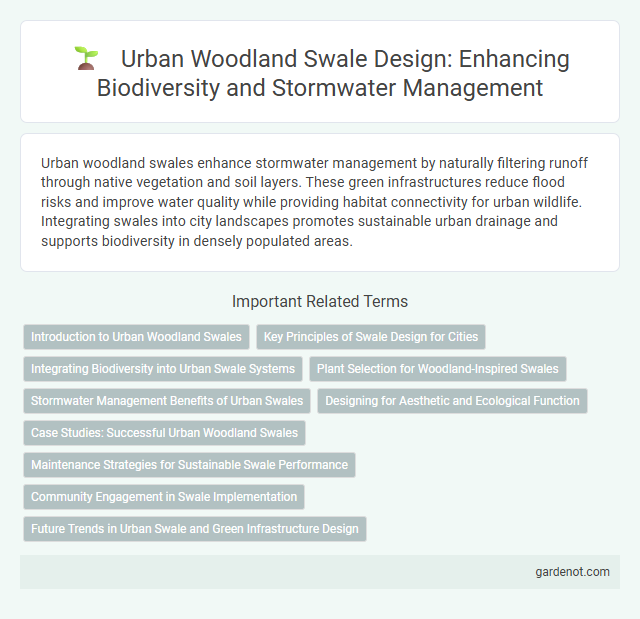Urban woodland swales enhance stormwater management by naturally filtering runoff through native vegetation and soil layers. These green infrastructures reduce flood risks and improve water quality while providing habitat connectivity for urban wildlife. Integrating swales into city landscapes promotes sustainable urban drainage and supports biodiversity in densely populated areas.
Introduction to Urban Woodland Swales
Urban woodland swales are engineered landscape features designed to manage stormwater by integrating natural vegetation and soil infiltration processes. These swales promote water filtration, reduce surface runoff, and enhance urban biodiversity through the incorporation of native trees and understory plants. Implementing urban woodland swales contributes to sustainable urban drainage systems (SUDS) while improving air quality and creating green corridors within city environments.
Key Principles of Swale Design for Cities
Urban woodland swale design prioritizes natural water filtration, biodiversity enhancement, and flood mitigation through vegetation and soil layers. Incorporating native trees and shrubs improves stormwater absorption, reduces runoff velocity, and supports urban wildlife habitats. Effective swale design also emphasizes soil permeability and strategic grading to maximize groundwater recharge and minimize surface erosion.
Integrating Biodiversity into Urban Swale Systems
Urban woodland swales enhance stormwater management by incorporating native trees and shrubs, which improve habitat connectivity and support local wildlife diversity. These green infrastructure elements foster ecological resilience through layered vegetation that filters pollutants and moderates microclimates. Integrating diverse plant species in swale design maximizes ecosystem services, including carbon sequestration and pollinator support, essential for urban biodiversity conservation.
Plant Selection for Woodland-Inspired Swales
Selecting plants for an urban woodland swale involves prioritizing native, shade-tolerant species that thrive in moist, well-drained soils to enhance stormwater management and support local biodiversity. Incorporating trees such as red maple (Acer rubrum) and understory shrubs like spicebush (Lindera benzoin) creates a layered canopy that mimics natural woodland structure. Ground covers including ferns and wild ginger help stabilize soil, reduce erosion, and improve infiltration while providing habitat for urban wildlife.
Stormwater Management Benefits of Urban Swales
Urban woodland swales effectively reduce stormwater runoff by enhancing infiltration and promoting natural filtration through soil and vegetation layers. These green infrastructure elements mitigate flooding and improve water quality by trapping sediments and pollutants before they reach waterways. Integrating native trees and shrubs within swales supports biodiversity while stabilizing soil and reducing erosion in urban environments.
Designing for Aesthetic and Ecological Function
Urban woodland swales blend stormwater management with ecological restoration by incorporating native tree species and understory plants that enhance biodiversity and habitat connectivity. Thoughtful design prioritizes naturalistic forms and seasonal interest, using layered vegetation to optimize pollutant filtration, slow water flow, and provide wildlife shelter. Integrating permeable pathways and seating areas within the swale adds aesthetic value while encouraging public interaction with urban green infrastructure.
Case Studies: Successful Urban Woodland Swales
Urban woodland swales, such as the Cheonggyecheon Restoration Project in Seoul and the Kingsbury Creek urban woodland swale in Portland, showcase effective stormwater management integrated with native tree species and understory vegetation. These case studies highlight improved water quality, enhanced biodiversity, and increased urban green space, demonstrating how swales support ecological resilience in city environments. Maintaining soil permeability and using native plant assemblages are key factors driving the success of these urban woodland swale implementations.
Maintenance Strategies for Sustainable Swale Performance
Urban woodland swale maintenance strategies emphasize regular inspection, debris removal, and vegetation management to ensure optimal stormwater infiltration and pollutant filtration. Implementing adaptive management practices such as periodic sediment removal and selective pruning enhances the swale's hydrological function and biodiversity. Consistent monitoring of soil moisture and plant health supports sustainable swale performance and long-term urban ecosystem services.
Community Engagement in Swale Implementation
Community engagement in urban woodland swale implementation fosters local stewardship and enhances biodiversity conservation efforts. By involving residents in planning, planting, and maintenance, these projects improve environmental awareness and create a sense of ownership. Collaborative initiatives with schools and neighborhood groups amplify educational outreach and promote sustainable urban water management practices.
Future Trends in Urban Swale and Green Infrastructure Design
Urban woodland swales are increasingly integrated into green infrastructure design to enhance stormwater management and urban biodiversity. Advances in native plant selection and soil bioengineering promote resilience against climate change while improving ecosystem services. Future trends emphasize multifunctional swales that combine water filtration, habitat creation, and recreational spaces within dense urban environments.
Urban woodland swale Infographic

 gardenot.com
gardenot.com